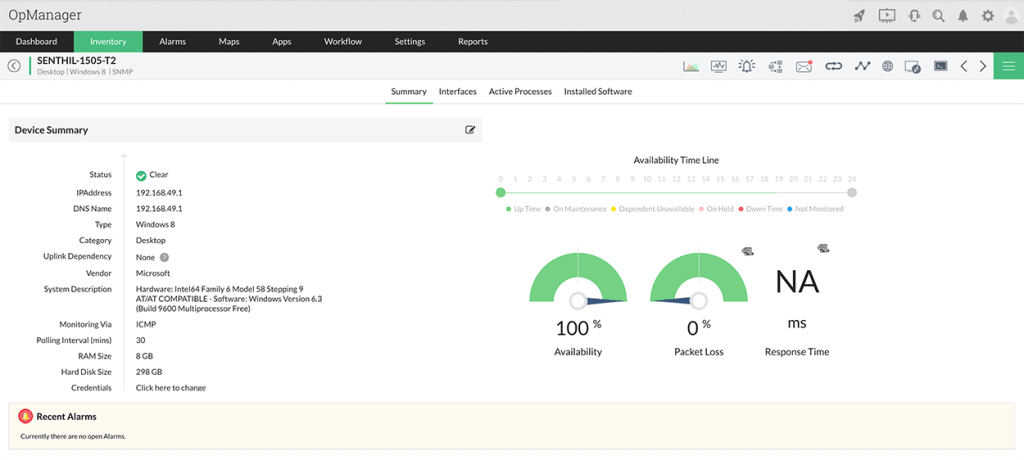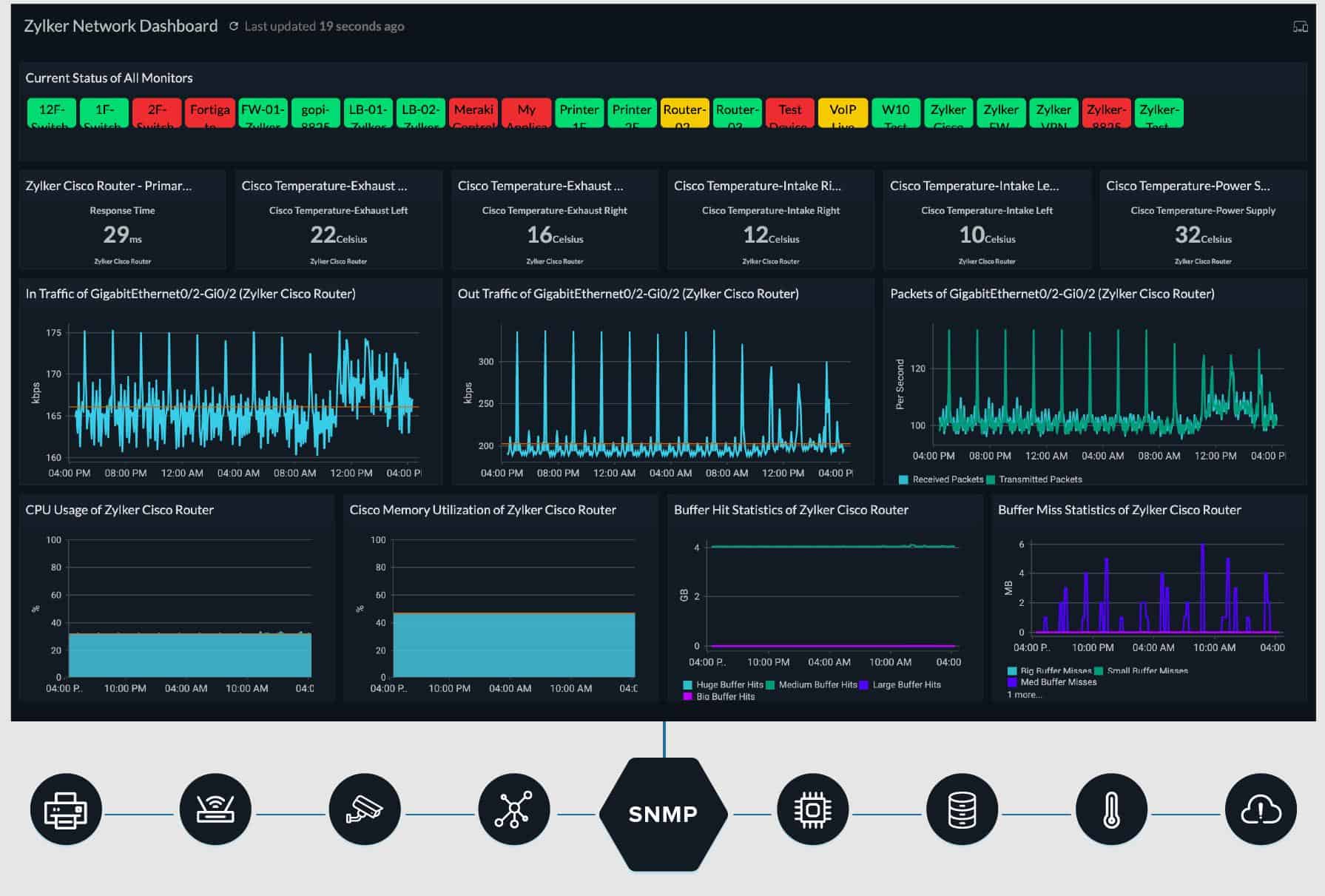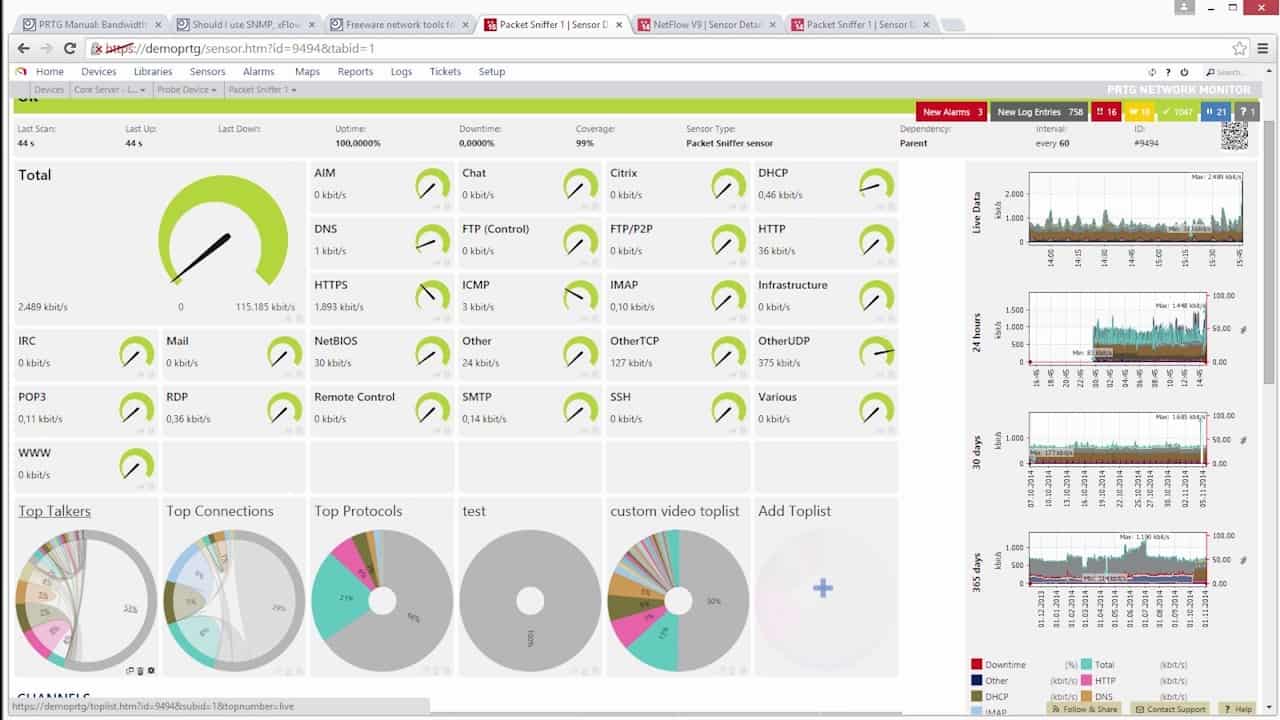We may earn a commission if you make a purchase through the links on our website.
Network Optimization – A Quick Guide to Get You Started!
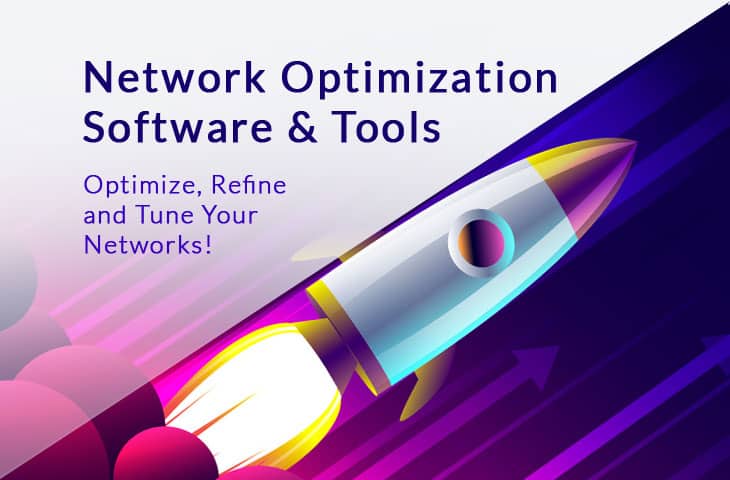
UPDATED: August 1, 2024
The internet is not only developing. It is exploding!
Here is our list of the top network optimization tools:
- ManageEngine OpManager – EDITOR'S CHOICE This tool monitors networks and servers and it uses SNMP to examine the load on network devices plus their availability statuses. Available for Windows Server and Linux. Download a 30-day free trial.
- Site24x7 – FREE TRIAL Excels as a network optimization software, meeting the demands of modern network environments focused on efficiency and performance. It offers advanced monitoring of network parameters like bandwidth, packet loss, and latency, coupled with AI-powered analytics for bottleneck resolution. Start a 30-day free trial.
- Paessler PRTG Network Monitor – FREE TRIAL A collection of monitors for networks, applications, and servers that includes SNMP performance reports, and live topology mapping. Runs on Windows Server. Access a 30-day free trial.
- SolarWinds Network Performance Monitor This SNMP-based system includes autodiscovery, network inventory creation, and automatic network topology mapping as bases for live activity monitoring.
- Progress WhatsUp Gold This network performance monitoring package works with SNMP and includes live network topology mapping. Runs on Windows Server.
Do I need Network Optimization?
The Internet is an expanding system of millions of connections, which is getting bigger and more complicated by the day. It's calculated that there will be 4.3 billion Internet users in the whole world by March 2019. But Internet usage increase is not only related to the population, it is also affected by the number of devices. Thanks to the Internet of Things “IoT,” it is expected that there will be more than 64 billion devices connected to the Internet worldwide by 2025.
This rapid growth is putting extreme pressure on our local networks. Our cloud storage, web apps, remote servers, VoIP calls, all of these depend entirely on the Internet.
To avoid poor end-user experience and lousy quality of service, you don’t have to go out and buy large and powerful resources. You only need to learn how to adapt and optimize your local networks.
What is Network Optimization?
Network Optimization is a set of technologies and methods that aim to improve the overall health of a network. It takes care of every single component, from the workstation to the server, their processes, and connections.
Network optimization helps you to keep track of specific performance metrics like bandwidth usage, availability, packet loss, latency, and jitter. It gives you essential information so that you can tweak what is necessary.
The goal of network optimization should not be to buy more powerful hardware or software resources but to optimize what is already in our hands. Traffic Engineering “TE” and Quality of Service “QoS” are two common optimization methods that can help improve the performance of these metrics in voice or data networks.
Why is Network Optimization Important?
Network optimization is essential for end-user experience, employee productivity and cutting down business costs.
For example, when there is latency in the network, an online application or website can take a long time to load. In other cases, packet loss, jitter, or delay can affect technologies such as VoIP or databases. Poor bandwidth allocation can also affect end-user experience and employee productivity.
Monitoring these factors and keeping them under certain thresholds is the key. Network Optimization aims to improve (or reduce) the following metrics:
- Uptime (availability)
- Bandwidth consumption or utilization
- Traffic
- Delay, Latency, Jitter
- Packet Loss
- Duplicate Packets
- Errors and discards
- CPU and memory
- WAN performance
Network Optimization with Tools
For now, no single product can be considered as a pure Network Optimization Tool. There are just too many factors that affect how a network behaves and how it should be optimized. But, there are a few tools that can help improve parameters through passive or active network performance monitoring.
These tools can help you, but will not automatically optimize your network. Adjusting it should be the role of the network engineer. New technologies such as Software-Defined-Networks “SDN” and Networks-Function-Virtualization “NFV” can also help improve it. With these technologies, network devices can now be controlled via code and their performance metrics optimized actively.
The tools listed below will help you monitor your traffic, metrics, protocols, and topologies. Some of these tools are beginning to support SDN and NFV monitoring.
Our methodology for selecting the right network optimization tool:
- Supports the autodiscovery feature that helps maintain a log of all network devices
- A network topology map building system
- SNMP monitoring feature to track the status of all live network devices
- A system for packet loss and network performance monitoring over time
- Robust reporting system that graphically interprets all data
- A free demo session or trial period for risk-free assessment
The Best Network Optimization Software & Tools
1. ManageEngine OpManager – FREE TRIAL
OpManager is a robust network monitoring and management software, developed by ManageEngine. This tool is capable of keeping track of your network performance in real-time and actively finds faults. With OpManager you can monitor every single device in your distributed networks, remote offices, and your cloud environments.
Key Features:
- Root Cause Analysis: Monitors each device and identifies the root cause of the problem for efficient troubleshooting
- Network Mapping: Allows users to map each device to get a clear view of issues and a better understanding
- Monitoring Device Availability: Watches over the availability status of each device and updates on identifying issues in real-time
- Customizable Dashboards: Enables users to customize monitoring dashboards to show important metrics and data based on individual requirements
- Instant Notification: Triggers an alarm and notifies admins through SMS or email on identifying security threats.
Why do we recommend it?
ManageEngine OpManager is a simple network optimization tool that helps drill down every key aspect of a device and offers a graphical user interface for Linux. Additionally, it automatically discovers and maps down all devices for enhanced visibility and quick anomaly detection.
OpManager allows network optimization in large networks. It has high scalability for up to 10,000 nodes while protecting their availability and uptime.
Who is it recommended for?
ManageEngine OpManager is compatible with all platforms and operating systems including AWS, Windows server, and Linux. It has been designed especially to run on Linux and is a great option for Linux users.
Pros:
- End-to-End Network Monitoring: Provides 200 customizable widgets and end-to-end visibility into network infrastructure that helps assess performance and bandwidth consumption
- Flexible Solution: Offers more flexibility than any other on-premise solutions, allowing you to install it on Windows as well as Linux operating systems
- Insightful Reporting: MSPs and enterprises find it an ideal choice for it offers in-depth reports and quick insights into the network infrastructure status
- Supports Multiple Alert Channels: Apart from email or SMS, the tool offers support to numerous alerting channels
Cons:
- Learning Curve: Since the tool comes with a wide range of functionalities, some users might take time to fully understand
OpManager comes with four different pricing models, Essential, Enterprise, Service Packs, and Free. Their price is not on the official site of ManageEngine, but you can request a quote. The Free OpManager edition, and optimize the performance for up ten devices for an unlimited time. Start with a 30-day free trial.
2. Site24x7 – FREE TRIAL
Site24x7 stands out as a prominent choice for network optimization software, catering to the needs of modern network environments where efficiency and performance are paramount. This tool is particularly effective for organizations aiming to enhance their network performance and reliability through advanced optimization techniques. Site24x7’s comprehensive approach to network optimization makes it an excellent choice for those seeking to maximize their network resources and improve user experience.
Key Features:
- Advanced Monitoring Features: Supports packet loss analysis, latency monitoring, bandwidth monitoring, and other advanced features that aid in improving overall network performance
- AI-Powered Analytics: Uses artificial intelligence algorithms to properly analyze all the data collected from different networks and provide quick insights
- Automated Network Configuration: Reduces the need for manual intervention and automates all the configuration process
- Customizable Alerts: Users can customize alert notifications as per their need and preference
Why do we recommend it?
Site24x7 is recommended for its robust network optimization capabilities, enhanced by AI-powered analytics and comprehensive performance monitoring. Its automated optimization tools and insightful analytics make it a valuable asset for any organization looking to improve network efficiency and reliability.
Who is it recommended for?
This tool is particularly suitable for network administrators and IT professionals in medium to large enterprises that manage complex network infrastructures. Its ability to provide a detailed overview of network performance and identify optimization opportunities makes it ideal for environments where network efficiency is critical.
Pros:
- Automate Discovery and Mapping: Uses Layer 2 maps to automate mapping and discover new devices across networks
- SNMP Trap Processing: Allows setting up network devices to transmit and receive processed alert messages for every defined trap in SNMP MIB
- AI-Powered Optimization: Uses artificial intelligence algorithms to identify patterns, analyze and generate insights for faster optimization
Cons:
- Complex for Small Businesses – Small network businesses that have basic optimization needs might find the tool too complex
3. Paessler PRTG Network Monitor – FREE TRIAL
PRTG Network Monitor is developed by Paessler GmbH, which is a large multinational company that creates IT infrastructure monitoring software. PRTG Network Monitor is an advanced monitoring tool for small, medium, and enterprise networks. With it, you can monitor any component in your infrastructure, such as servers and systems, applications, hardware, traffic, databases, Wireless Access Points, storage, bandwidth, cloud, virtual, security, IoT, etc.
Key Features:
- Bandwidth Usage Monitoring: Watches over bandwidth use to identify the points of congestion and improve status
- Network Device Scanning: Run scans and discovers new network devices automatically
- Custom Dashboards: Displays key metrics and information depending on the user's preference
Why do we recommend it?
Paessler PRTG is a flexible network optimization tool that creates real-time network maps for better understanding and analysis of networks. Along with supporting integration for alert systems and other channels, it aids in network stabilization.
PRTG monitors the following key network optimization indicators:
- Uptime PRTG can help you keep your uptime to 24/7. It provides detailed statistics of the availability so that you can find sources of errors and reduce downtime.
- Bandwidth Keep track of the bandwidth utilization in your network and test it frequently to ensure the SLA from the provider. PRTG uses SNMP, WMI, and Netflow to give you an overview of performance data.
- Latency The PRTG network utility helps you track the lag in your network. It uses a QoS sensor to find packet delay, loss, jitter, and duplicate packets.
PRTG has a flexible licensing model based on sensors and supports most popular networking vendors. It uses monitoring sensors, which are components within a single device. Sensors give a lot of flexibility. They can monitor an element such as CPU utilization, bandwidth, HTTP, etc. A single device can have one or up to a hundred sensors.
This tool can help you optimize your network by providing broad information on every single component. Once you see a failure in a node in PRTG’s dashboard, you can configure the hardware or software.
Who is it recommended for?
Be it small or large companies, each can invest in the tool and activate the bundle as per their requirement. As a result, they can remove any extra services from the plan that they do not need and will not have to pay for. Furthermore, the bundle is free if customers just activate 100 sensors.
Pros:
- Network Performance Reporting: Finds new devices and reports network performance using a variety of methods, including packet sniffer, WMI, and SNMP
- Autodiscovery: Discovers and automatically updates the most recent inventory changes
- Alert Options: Supports a wide range of channels and third-party integrations to notify users about issues
Cons:
- Difficult to Set Custom Sensors: Manually configuring custom sensors can be difficult for most users at times.
PRTG is 100% free for up to 100 sensors. You can upgrade to a paid license, that starts at $1,600 (USD) for PRTG 500, which allows monitoring up to 500 sensors and one server installation. You can run up to 100 sensors for free, and you can start with a 30-day free trial.
4. SolarWinds Network Performance Monitor
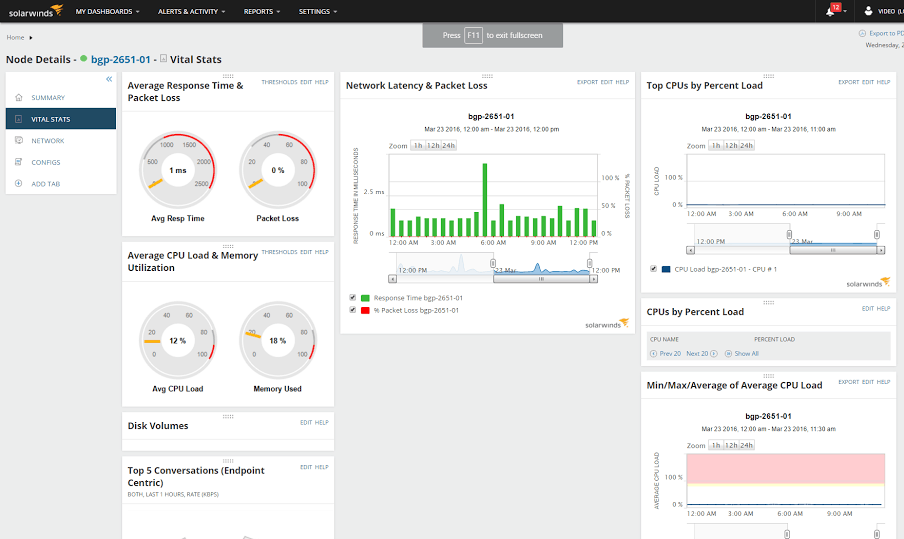
Network Performance Monitor developed by SolarWinds, is one of the best network management and monitoring tools on the market. NPM is an intuitive and easy-to-use software. It can monitor performance, availability, and faults on your network.
Key Features:
- Network Monitoring for Multiple Vendors: Enables network administrators to keep track of all network devices and equipment from various companies in one place.
- SolarWinds NPM Supports SDN Monitoring: Uses Simple Network Management Protocol to monitor key performance metrics of network devices and identify issues in real-time.
- Network Device Autodiscovery: Identifies and lists all the connected network devices automatically without any human intervention
- Hop-by-Hop Analysis of Paths: Helps visualize network routes and track each node across multiple paths to identify bottlenecks and improve the flow of traffic.
- Automatically-Generated Intelligent Maps: Represent all the network paths and topology in a visual manner for better understanding and traffic flow optimization.
- WiFi Heat Maps: Provides accurate updates on the strength of WiFi signals and coverage areas
- Powerful Alerting System: Sends instant alerts on noticing anything suspicious in network events or anomalies for quick resolution.
Why do we recommend it?
SolarWinds Network Performance Monitor (NPM) is an automated network monitoring and optimization solution that discovers devices in real time, maps them, and finds faults at an early stage. Additionally, it comes with various advanced options such as NetPath critical path visualization and SDN monitoring that facilitate efficient network management.
NPM allows you to optimize the network by displaying faulty nodes and letting you view its current state, information, average response time, packet loss, latency, CPU, etc. For example, with NPM, you can see that the status of a node is up and running but its metrics such as Round-Trip Time “RTT” and packet loss are high.
You can analyze these metrics and implement network optimization with NPM. The software includes a Quality of Experience “QoE” dashboard that uses Deep-Packet-Inspection “DPI” to provide you with packet-level traffic information and to calculate network latency. With this information, you can find the sources of network issues and improve your network.
Who is it recommended for?
The tool is suitable for all sizes of enterprises but small businesses must compare other options as it comes with a wide range of features that can be too much to handle.
Pros:
- Network Availability Monitoring: Follows a holistic approach to monitor interfaces, performance, and availability of networks and reduce downtime
- Comes with Autodiscovery Feature and Mapping Tools: Helps discover connected network devices automatically and create custom maps for a better understanding of traffic flow
- Critical Path Visualization: Offers complete visibility into the network and performs hop-by-hop analysis along the different paths for quick identification of problems
- Robust Reporting and Alert System: Comes with alerting features that help detect anomalies easily as well as creates comprehensive reports on network trends and performance
Cons:
- Not Ideal Solution for Small Businesses: Designed with multiple features keeping large and enterprise networks in mind, but small businesses might find it overwhelming
Start with a 30-day free trial and figure out what your requirements are.
5. Progress WhatsUp Gold
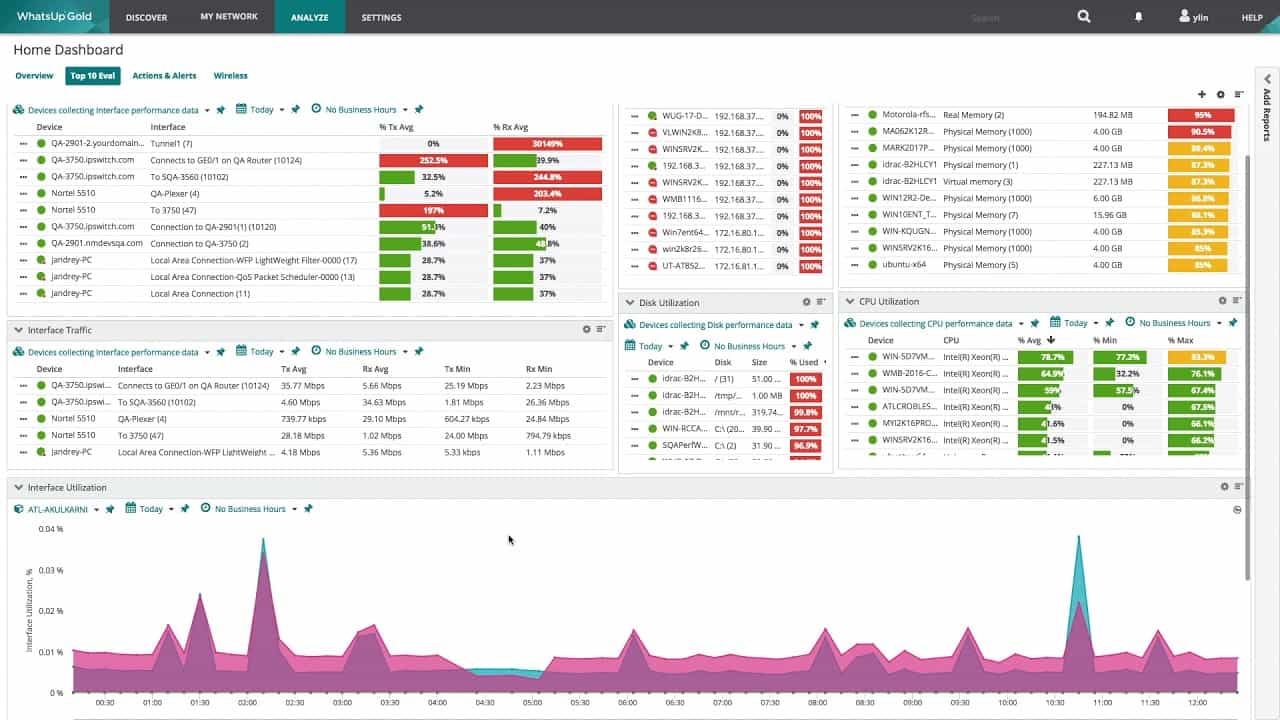
WhatsUp Gold“WUG,” developed by Progress, is another network management and monitoring software. This tool can keep track of the availability and performance of the entire infrastructure for small to medium size networks.
Key Features:
- Network Mapping: Helps map and visualize all networks and interdependencies for quick analysis
- Support REST API: Makes integrating it with your own scripts or systems simple.
- Bandwidth Monitoring: Keeps track of bandwidth usage using sFlow, jFlow, and NetFlow technologies
Why do we recommend it?
Progress WhatsUp Gold comes with out-of-the-box functionalities that help discover and fix network issues quickly and maintain overall health and integrity. It offers Dynamic SNMP Table Monitoring and other security features that make it a good choice.
How to optimize your network with WhatsUp Gold:
- Bandwidth Optimization:
Network Traffic Analysis plug-in module allows you to monitor bandwidth and analyze traffic. The solution uses a variety of protocols such as NetFlow, NSEL, QUIC, sFlow, J-Flow, and IPFIX. - Ping status/latency:
WUG is capable of checking latency and availability through ping response time measurements, and send alerts if there is no response or too much packet loss. - Monitor performance of applications:
A tool such as VoIP monitor is capable of continuously assessing performance and health of VoIP call quality. Another one is SQL Server monitor, which can monitor your SQL database and send alerts if there is a failure. - QoS Policies:
Give different priorities to different types of traffic with QoS policies. Allocate the right bandwidth to the most critical applications such as VoIP, CRP, databases, etc.
WhatsUp Gold gives you an overall view of the health of the network, devices, applications, and servers on-premises or in the cloud. It comes with a simple-to-use but comprehensive dashboard that will show newly discovered devices, statistics, and failure alerts.
Who is it recommended for?
All IT professionals and network administrators who want to optimize their network infrastructure and ensure intuitive workflows must go in with Progress WhatsUp Gold.
Pros:
- Monitors Newly Discovered Devices: Discovers new devices and starts monitoring them automatically
- Simple Visualizations: Monitors all network types and report status using simple visualizations to offer quick insights
- Modular Pricing: Enabling businesses to pay only for the capabilities or features they plan to utilize
Cons:
- Optimal Feature Utilization Challenges: If you plan to use every feature of this tool, modular upgrades might not be the best option.
The price for WUG is not in the official site, so you’ll need to get a quote. Get a free trial on WUG from the official site.
Conclusion
The growth of the Internet is putting extreme pressure on our networks. Our local communication with remote servers, customers on the other side of the world, cloud storage, and even our mobiles depend entirely on the Internet.
If your network is already weak, it may cause poor quality of service to end-users. Even worst, it could make your employees unproductive and probably make a few customers unhappy. Your network needs to be ready and able to adapt to this growth.
But going out and buying more powerful resources is not always the best solution. You only need to learn how to optimize your current network with the help of a few methodologies and tools. Making sure your network design is at its best, and at the lowest possible cost is the best way to start.
Network Optimization can help in faster data transfers, improve disaster recovery, decrease bandwidth expenses, and improve response times for critical applications such as VoIP or databases.
All the tools listed above will help you optimize your network by analyzing performance metrics. But \SolarWinds NPM is the only one on the list that just started to support SDN monitoring, which can make a huge difference in terms of automatically optimizing your network via code.
Network Optimization FAQs
How often should I perform network optimization?
The frequency of network optimization depends on the specific requirements of your environment and the size and complexity of the network. In general, it is recommended to perform regular network optimization on an ongoing basis to ensure that the network is running optimally and to identify and resolve issues as they arise.
What should I do if I encounter a performance issue with the network?
If you encounter a performance issue with the network, the first step is to gather information about the issue and the environment, including network utilization and response time. You can then use this information to identify the root cause of the issue and take appropriate action, such as reconfiguring network devices, upgrading network components, or optimizing network bandwidth. If the issue cannot be resolved, you may need to seek additional support from the vendor or the network administrator.
How do I optimize network bandwidth?
Network bandwidth can be optimized by implementing bandwidth management techniques, such as traffic shaping, bandwidth limiting, and quality of service (QoS) policies. These techniques allow network administrators to control how network resources are used and prioritize network traffic to ensure that critical applications receive the necessary network resources.
What is the difference between network optimization and network tuning?
Network optimization and network tuning are similar in many ways, as both involve improving the performance and efficiency of a computer network. However, network optimization typically involves making broader changes to the network, such as reconfiguring network devices, upgrading network components, or implementing security measures. Network tuning, on the other hand, typically involves making more targeted changes to network settings and configurations to improve network performance.
